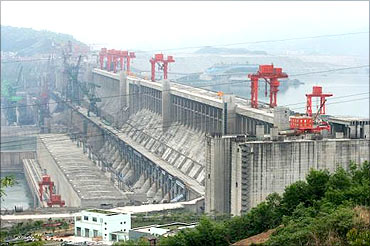
Further boosting its ranking as the world's largest producer of hydro-electric power, China on Wednesday commissioned a new 700,000 kw unit at Xiaowan, built at a whopping cost of $5.86 billion.
As the Communist nation races to meet its Copenhagen commitments to reduce green house gases, the Xiaowan station in the southwestern Yunnan Province, upgraded China's installed hydro-electric power capacity just above 200 million kilowatts.
China's hydro-electric power capacity is the world's largest. The $5.86 billion Xiaowan is China's second largest hydro power project after the world biggest Three Gorges dam which has capacity to produce 700 mw of power.
Click NEXT to read on . . .

The new project could produce 19 billion kWh of electricity every year.
"The rapid development of the hydro power industry is of great significance to optimising China's energy structure and reducing carbon emissions," Sun Yucai, executive vice chairman of the China Electricity Council, said at the ceremony to commission the project.
China promised at the Copenhagen Conference on Global Climate Change last year that China would cut its carbon emissions per unit of gross domestic product by 40 to 45 per cent by 2020.
It also undertook a commitment to generate 15 per cent of its power from non-fossil sources by 2020, up from the current 7.8 per cent.
As the most competitive non-fossil energy, hydro power was the key for China to realise its emissions reduction goal, Sun said.
Hard pressed to meet its Copenhagen commitments to reduce green house gases, China will expand its hydro power capacity to 300 million kw by 2015 from the current 200 million kw in an effort to cut emissions, Zhang Guobao, director of the National Energy Administration, said.
China has long relied on coal to fuel its economic growth with about 83 per cent of its electricity produced by coal-fired stations. China's annual hydro electricity production is 585.2 TWh, which is the largest in the world.
Click NEXT to read on . . .

The country is followed by Canada (369.5 TWh) and Brazil (363.8 TWh). To match the installed hydro power capacity of 200 million kilowatts, thermal power plants would have to burn 288 million tonnes of coal equivalent, emit 855 million tonnes of carbon dioxide and 5.4 million tonnes of carbon sulphur dioxide every year, according to China Electricity Council estimates.
Zhang said that hydro projects with another 70 million kilowatts capacity were under construction, and another 100 million kilowatts of capacity was needed.
"If all the planned hydro power projects begin construction in the next three years, it is still possible to expand the current installed hydro power capacity to 380 million kilowatts by 2020," Zhang said.